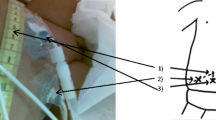Abstract
Continuous renal replacement therapy (CRRT) has become an important supportive therapy for critically ill children with acute renal failure. In Turkey, commercially available diafiltration and replacement fluids cannot be found on the market. Instead, peritoneal dialysis fluids for dialysis and normal saline as replacement fluid are used. The first objective of this study was to examine metabolic complications due to CRRT treatments. The second objective was to determine demographic characteristics and outcomes of patients who receive CRRT. We did a retrospective chart review of all pediatric patients treated with CRRT between February and December 2004. Thirteen patients received CRRT; seven survived (53.8%). All patients were treated with continuous venovenous hemodiafiltration. Median patient age was 71.8 ± 78.8 (1.5–180) months. Hyperglycemia occurred in 76.9% (n = 10), and metabolic acidosis occurred in 53.8% (n = 7) of patients. Median age was younger (48.8 vs.106.2 months), median urea level (106.2 vs. 71 mg/dl) and percent fluid overload (FO) (17.2% vs. 7.6%, respectively) were higher, and CRRT initiation time was longer (8.6 vs 5.6 days) in nonsurvivors vs. survivors for all patients, although these were not statistically significant. CRRT was stopped in all survivors, and four nonsurvivors (67%) were on renal replacement therapy at the time of death. Hyperglycemia and metabolic acidosis were frequently seen in CRRT patients when commercially available diafiltration fluids were not available. Using peritoneal dialysis fluid as dialysate is not a preferable solution. Early initiation of CRRT offered survival benefits to critically ill pediatric patients. Mortality was associated with the primary disease diagnosis.
Similar content being viewed by others
References
Tantalean JA, Leon RJ, Santos AA, Sanchez E (2003) Multiple organ dysfunction in children. Pediatr Crit Care Med 4:181–185
Williams DM, Sreedhar SS, Mickell JJ, Chan JC (2002) Acute kidney failure: a pediatric experience over 20 Years. Arch Pediatr Adolesc Med 156:893–900
Odetola F, Bratton S, Clark S, Davis M (2004) Availability of advanced therapeutic modalities in US pediatric intensive care units-2004. Crit Care Med 32 (Suppl):A86
Marcin JP, Pollack MM (2000) Review of the methodologies and applications of scoring systems in neonatal and pediatric intensive care. Pediatr Crit Care Med 1:20–27
Leteurtre S, Martinot A, Duhamel A, Proulx F, Grandbastien B, Cotting J, Gottesman R, Joffe A, Pfenninger J, Hubert P, Lacroix J, Leclerc F (2003) Validation of the paediatric logistic organ dysfunction (PELOD) score: Prospective, observational, multicentre study. Lancet 362:192–197
Schwartz GJ, Brion LP, Spitzer A (1987) The use of plasma creatinine for estimation glomerular filtration rate in infants, children, and adolescents. Pediatr Clin North Am 34:571–590
Maxvold NJ, Bunchman TE (2003) Renal failure and renal replacement therapy. Crit Care Clin 19:563–575
Goldstein SL, Currier H, Graf JD, Cosio CC, Brewer ED, Sachdeva R (2001) Outcome in children receiving continous venovenous hemofiltration. Pediatrics 107:1309–1312
Expert Committee on the diagnosis and classification of diabetes mellitus (2000) Report on the expert Committee on the diagnosis and classification of diabetes mellitus. Diabetes Care 23 (Suppl 1):S4–S19
Stone B (2005) Fluids and Electrolytes. In: Robertson J, Shilkofski N (eds) The Harriet lane handbook. Elsevier Mosby, Philadelphia, pp. 283–308
Bunchman TE, McBryde KD, Mottes TE, Gardner JJ, Maxvold NJ, Brophy PD (2001) Pediatric acute renal failure: outcome by modality and disease. Pediatr Nephrol 16:1067–1071
Stickle S, Brewer ED, Goldstein SL (2002) Pediatric (PED) acute renal failure (ARF) update: epidemiology and outcome from a three and one-half year experience. J Am Soc Nephrol 13:649 (abstract).
Zimmerman D, Cotman P, Ting P, Karanicolas S, Tobe SW (1999) Continous veno-venous haemodialysis with a novel bicarbonate dialysis solution: prospective cross-over comparison with a lactate buggered solution. Nephrol Dial Transplant 14:2387–2391
Barenbrock M, Hausberg M, Marzkias F, de la Motte J, Schaefer RM (2000) Effects of bicarbonate-and lactate buffered replacement fluids on cardiovascular outcome in CVVH patients. Kidney Int 58:1751–1757
Bonnardeaux A, Pichette V, Ovimet D, Geadah D, Habel F, Cardinal J (1992) Solute clearance with high dialysate in continous arteriovenous hemodialysis. Am J Kidney Dis 19:31–38
Monnaghan R, Watter JM, Clancey SM, Houlton SB, Rabin EZ (1993) Uptake of glucose during continous arteriovenous hemofiltration. Crit Care Med 21:1159–1163
Reynolds HN, Borg U, Belzberg H, Wiles CE (1991) Efficacy of continous arteriovenous hemofiltration with dialysis in patients with renal failure. Crit Care Med 19:1387–1394
Van Den Berghe G, Wouters P, Weekers F, Verwaest C, Bruyninckx F, Schetz M, Vlasselaers D, Ferdinande P, Lauwers P, Bouillon R (2001) Intensive insulin therapy in critically ill patients. N Engl J Med 345:1359–1367
Srinivasan V, Spinella PC, Drott HR, Roth CL, Helfaer MA, Nadkarni V (2004) Association of timing, duration, and intensity of hyperglycemia with intensive care unit mortality in critically ill children. Pediatr Crit Care Med 5:329–336
Maxvold NJ, Smoyer WE, Gardner JJ, Bunchman TE (1997) Management of acute renal failure in the pediatric patient: hemofiltration versus hemodialysis. Am J Kidney Dis 30:84–88
Smoyer WE, McAdams C, Kaplan BS, Sherbotic JR (1995) Determinants of survival in pediatric continous hemofiltration. J Am Soc Nephrol 6:1401–1409
Goldstein SL, Somers MJ, Baum MA, Symons JM, Brophy PD, Blowey D, Bunchman TE, Baker C, Mottes T, McAfee N, Barnett J, Morrison G, Rogers K, Fortenberry JD (2005) Pediatric patients with multi-organ dysfunction syndrome receiving continous renal replacement therapy. Kidney Int 67:653–658
Foland JA, Fortenberry JD, Warshaw BL, Pettignano R, Merritt RK, Heard ML, Rogers K, Reid C, Tanner AJ, Easley KA (2004) Fluid overload before continous hemofiltration and survival in critically ill children: a retrospective analysis. Crit Care Med 32:1771–1776
Proulx F, Gauthier M, Nadeou D, Lacroix J, Farell CA (1994) Timing and predictors of death in pediatric patients with multiple organ system failure. Crit Care Med 22:1025–1103
Author information
Authors and Affiliations
Corresponding author
Rights and permissions
About this article
Cite this article
Soysal, D.D., Karaböcüoğlu, M., Çıtak, A. et al. Metabolic disturbances following the use of inadequate solutions for hemofiltration in acute renal failure. Pediatr Nephrol 22, 715–719 (2007). https://doi.org/10.1007/s00467-006-0380-3
Received:
Revised:
Accepted:
Published:
Issue Date:
DOI: https://doi.org/10.1007/s00467-006-0380-3




